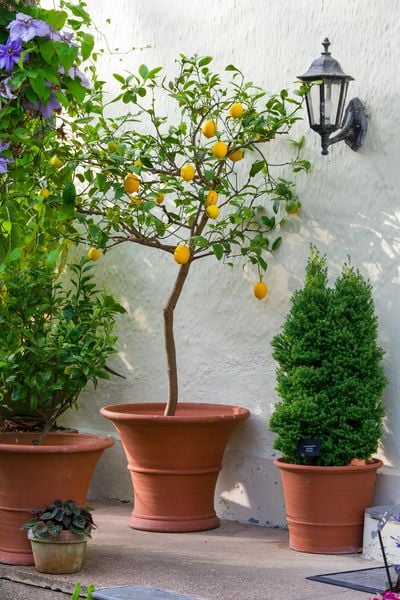Overwintering plants in conservatories
In frost-prone areas a conservatory is the ideal place for overwintering tender perennials and marginally hardy plants from the garden. Cold-sensitive plants in need of good light levels and dry, frost-free conditions will also benefit. Tropical plants and exotics can be moved inside during autumn after a spell in the garden through the summer months.

Quick facts
Timing Usually late summer to autumn
Difficulty Easy to moderate
Jump to
Suitable for...
A heated conservatory provides a warm and light environment but can be expensive to run. Day temperatures of 15-20ºC (60-70ºF) are ideal with some heating maintained at night to avoid an extreme drop in temperature.
Examples of plants requiring this environment include:
- Begonia, Brugmansia, Colocasia, Gardenia, Pelargonium, standard fuchsia and will enjoy the better light levels in a heated conservatory during winter which may not be available in the house
- Orchids, particularly Cymbidium which benefit from a shady outdoor position in summer can be brought back inside for the winter months
An intermediate conservatory suits a range of plants that tolerate an even, cool temperature of about 10ºC (50ºF).
Plants preferring these conditions include:
- Hibiscus rosa-sinensis, Plectranthus and Plumbago
- Bougainvillea, Citrus, Clivia, Stephanotis and Tibouchina will tolerate a cool conservatory if watered sparingly
Even without heating a cool conservatory providing a minimum of 5-7ºC (41-45ºF) makes an ideal place to overwinter tender plants from the garden.
Plants that suit these conditions include:
- Container grown climbers such as Jasminum polyanthum, Rhodochiton atrosanguineus and Sollya heterophylla
- Cool but frost-free conditions will benefit tender Echium, Salvia, and the often vulnerable southern hemisphere plants Callistemon, Cordyline and Grevillea
- Exotics such as bananas, palms and tree ferns are vulnerable to frost damage, particularly when young, so will benefit from a spell under glass during the worst of the freezing temperatures
- Containers of succulent Agave or Echeveria and bulbous plants such as Freesia and Nerine sarniensis need dry as well as frost-free winter conditions
When to bring plants in from the garden
Tender plants may be damaged by the cold, so it is best not to leave them outdoors, even if they are under cover;
- Keep an eye on the weather forecast in early autumn and be prepared to bring in plants at short notice
- Local weather conditions will dictate when it may be necessary to lift and move vulnerable plants inside. This could be when temperatures drop below 12-15ºC (54-59ºF), possibly from September onwards
- In the milder parts of southern England it may be well into November before some plants must relocate to warmer or frost-free conditions
How to relocate plants from the garden
When moving plants from outside to inside, follow these easy steps:
- Lift required plants using a border spade or use a fork to prise the plants out of the soil with as much of the root ball undisturbed as possible
- Shake off as much soil as possible and trim the stems
- Using fresh potting compost repot the prepared plants and keep cool and dry
- Container-grown plants can be stored in their pots after a light trim and the removal of any dead and diseased leaves
Problems
Check plants carefully for any pests or diseases they may have picked up in the garden. Tip plants out of the pot and examine for any soil pests such as vine weevil. Many plants such as fuchsia are susceptible.
- Maintain air movement to help reduce problems with fungal diseases such as grey mould (Botrytis cinerea)
- Mealybugs can hide in nooks and crannies
- Sooty mould may be a problem especially on citrus. Check for scale insects or aphids
- Check under leaves for signs of pelargonium rust or fuchsia rust
- Warm conservatory environments can be ideal for glasshouse red spider mite and glasshouse whitefly
In addition:
- Watch out for overwatering and be careful to water sparingly through winter
- Brown and shrivelled leaf tips, leaf edges yellowing or wilting are usually a sign of insufficient humidity around the foliage and should not be mistaken for lack of water. Mist the foliage or stand the container on a tray of moist pebbles. Group plants together to increase air humidity around the foliage
Propagation of overwintering tender perennials and shrubs
To ensure a supply of fresh young plants for a display next year you can take softwood cuttings in summer.
Salvia cuttings will root easily from either the tender or hardy species.
Get involved
The Royal Horticultural Society is the UK’s leading gardening charity. We aim to enrich everyone’s life through plants, and make the UK a greener and more beautiful place.